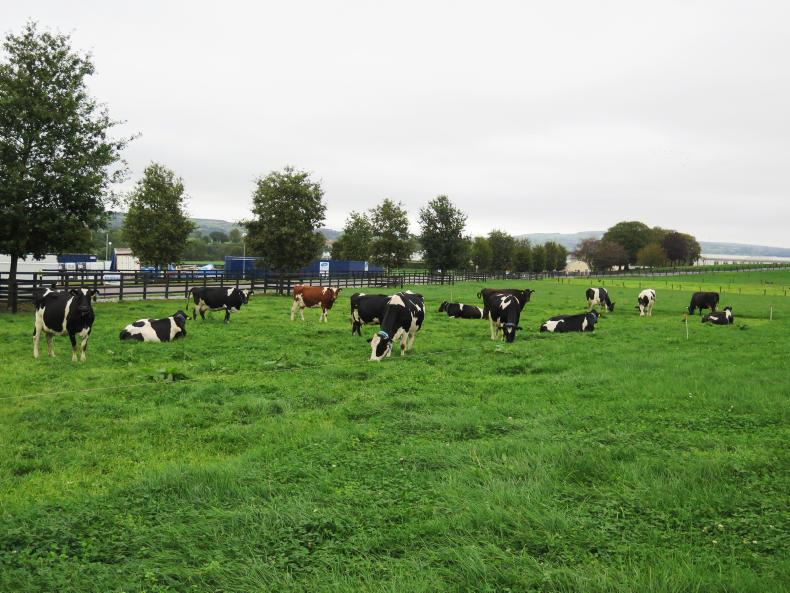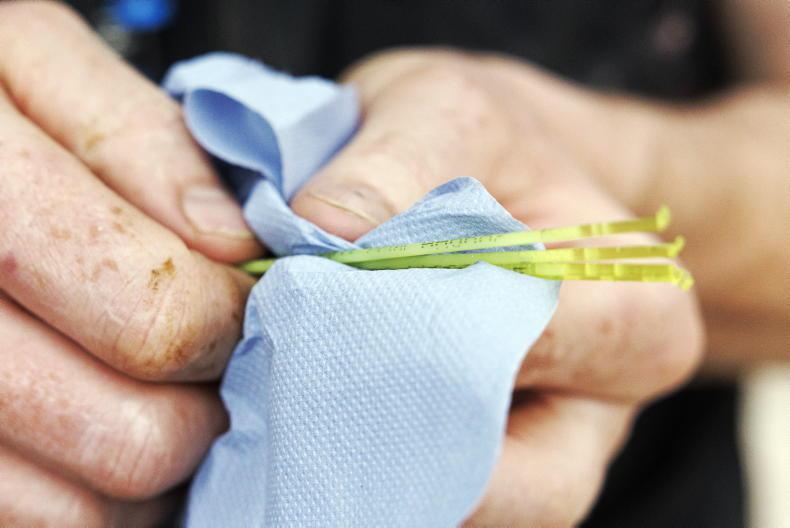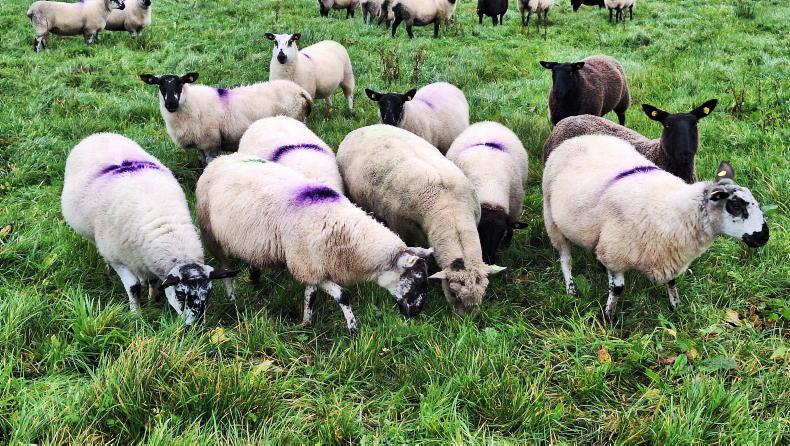The 2020 spring-calving season has arrived and indications are it is going to be another busy year. Recent CSO figures show the number of dairy cows in Ireland has increased to 1.5m, while ICBF reported on average 65% of cows calving within the first six-weeks of the calving season, an increase of 8% since 2015. A greater number of cows calving more compactly means an increased workload for the farmers during spring.
While twice-a-day (TAD) milking is accepted as the standard milking frequency, more dairy farmers are challenging this theory for a number of reasons. The increased spring workload due to cows calving, calf feeding and difficulties employing suitable staff have all contributed to farmers looking to using once a day (OAD) or adaptations of OAD during the year. A recent Teagasc Moorepark survey conducted in Munster showed that almost 10% of the herds enrolled in the study were milking OAD until the start of March.
New research programme
In spring 2018, a new programme of work investigating OAD milking commenced at Teagasc Moorepark. The study investigated the effect of both short-term OAD milking at the start of lactation and also full-time OAD milking on dairy cow production, labour input and animal welfare throughout the entire lactation.
OAD milking in early lactation
The Moorepark studies have looked at milking cows OAD for two, four, six or eight weeks in early lactation and compared their performance to cows milked TAD for the full lactation. As soon as the cows that were assigned to the OAD treatments calved, they were milked OAD until their respective times on OAD had finished. After this, they returned to TAD milking for the remainder of lactation.
The results showed that there is an immediate reduction in production when cows are milked OAD. Milk yield is reduced by up to 24% and milk solids yield (fat kg plus protein kg) is reduced by up to 23% during the OAD period, when compared to cows milked TAD during the same period. The studies also found that when cows return to TAD milking their milk production immediately increases, to a level similar to the TAD cows.
At drying off, there was no difference in cumulative milk solids yield between any of the treatments. Milking cows OAD for six or eight weeks at the start of lactation did reduce the milk yield (volume) of these cows compared with cows milked TAD for the full lactation. However, there was no reduction in milk yield when cows were milked OAD for two or four weeks at the start of lactation.
ICBF reported on average 65% of cows calving within the first six-weeks of the calving season, an increase of 8% since 2015
The somatic cell count (SCC) of cows milked OAD was no different between treatments. Also, there was no difference in locomotion score, an indicator of lameness, between treatments.
The study did find a saving of over 30% in milking time by milking cows OAD and this did not include the reduction in time spent collecting cows for milking or washing up time so, in reality, the labour savings are greater.
These results clearly show that OAD milking can have a role on all farms in early lactation. For example, if cows were milked OAD for the month of February, the maximum length of time cows would spend on OAD would be four weeks, while some cows would spend less than a week. By milking cows OAD, it allows time to be made available for other routine tasks, such as calf care, and it may also help to alleviate the pressure farmers are exposed to during the calving season.
Full-time OAD milking
As well as short-term OAD milking some farmers are considering the option of full-time OAD milking. Although OAD milking offers benefits such as improved energy balance due to lower bodyweight and body condition score (BCS) loss, which can result in improved fertility performance, there are potential drawbacks. These include a reduction in milk production and increased SCC, which may result in decreased farm profitability.
In spring 2019, a full-time OAD herd was established at Teagasc Moorepark with a view to maintaining the herd for the next two years to fully understand the effects of OAD milking compared to TAD. The cows had an average EBI of €164 and were chosen randomly from the main Moorepark herd. The results to date have been very interesting.
The study did find a saving of over 30% in milking time by milking cows OAD and this did not include the reduction in time spent collecting cows for milking or washing up
While many believe that heifers do not perform well in a OAD milking system, the results from the study showed that the heifers did not react differently to mature cows.They both had proportionately the same reduction in milk solids production.
After 10 weeks of the experiment, the OAD cows were yielding 22% less milk yield and 15% less milk solids than the TAD cows. By the end of lactation, the TAD cows yielded 511kg/cow milk solids and the OAD cows yielded 396kg/cow over their lactation, a 23% reduction. Peak milk solids production was 2.2kg/cow/day (22 litres/day) for the OAD cows and 2.3kg/cow/day (28 litres/day) for the TAD cows.

The once a day milking group in Moorepark.
While SCC increased by approximately 40,000 for the OAD cows, there were no differences in mastitis incidences (five cases in the TAD herd and four cases in the OAD herd).
The fertility performance of the OAD cows was better than the TAD herd. The OAD cows had a higher conception rate to first service (almost 20% higher) and a lower not in-calf rate (12% difference) compared with the TAD cows. From week 20 onwards, the OAD cows had a much higher bodyweight and body condition score (BCS) than the TAD cows. At the end of lactation, the OAD cows were a BCS of 3.4 and (+40kg in bodyweight) and are being managed over the winter to ensure they do not put on any more condition.
Milk lactose and lactation length
Milk lactose dropped below 4.3% and became an issue from 250 days of lactation onwards. At this time, the milk yield of the OAD cows was also reducing and was less than 7kg/cow/day.
Due to the lower yields and low lactose levels, the OAD cows were dried earlier, resulting in a 15-day shorter lactation length when compared with the TAD cows that had 289 days of lactation. It should be noted that the OAD cows were managed to minimise the decline in production and this was achieved through good grassland management.

Factors in successful OAD milking
The initial outcomes from this work suggest that grassland and herd management skills need to be very good if considering OAD milking, especially on a full-time basis. There is only one chance to get the grazing allocations and milking process right with this system.
Management and milking time need to be consistent. A good milking routine is essential as this will help to minimise incidences of mastitis and will help maintain a low SCC. The milking routine used in Moorepark daily is teats stripped, pre-dipped, dry-wiped, clusters on and post-dipped (Deosan). This was the routine for the year.
Perhaps one of the most important aspects of achieving high performance from a OAD herd is grassland management. The best way of achieving this is by using as much grass as possible.
A good milking routine is essential as this will help to minimise incidences of mastitis and will help maintain a low SCC
High levels of concentrate are not the answer to achieving high performance, the variables costs need to be kept low. Pre-grazing yields should be maintained between 1,400kg and 1,600kg DM/ha and post-grazing heights should be 4cm to 4.2cm. Cows can be allocated grass on a 12-hour basis during the first rotation and on a 24- to 36-hour basis from the second rotation onwards.
Full-time OAD milking or adaptations of it will not be for everyone, but the research to date shows that it can be an option for many people. Many farmers want to reduce the number of evening milkings and short-term OAD is the way to do this without any associated cost.
No difference in lactation milk solids yield when short-term OAD milking is used at lactation start. High levels of milk production possible (400kg milk solids/cow) with full-time OAD milking. High levels of grassland/milking management is necessary with full-time OAD.Withdrawal for early lactation milk and mastitis treatments may need to be extended when milking OAD. Read more
Once-a-day Moorepark trial yields good results
Dairy management: calves, commodity prices and hedging
The 2020 spring-calving season has arrived and indications are it is going to be another busy year. Recent CSO figures show the number of dairy cows in Ireland has increased to 1.5m, while ICBF reported on average 65% of cows calving within the first six-weeks of the calving season, an increase of 8% since 2015. A greater number of cows calving more compactly means an increased workload for the farmers during spring.
While twice-a-day (TAD) milking is accepted as the standard milking frequency, more dairy farmers are challenging this theory for a number of reasons. The increased spring workload due to cows calving, calf feeding and difficulties employing suitable staff have all contributed to farmers looking to using once a day (OAD) or adaptations of OAD during the year. A recent Teagasc Moorepark survey conducted in Munster showed that almost 10% of the herds enrolled in the study were milking OAD until the start of March.
New research programme
In spring 2018, a new programme of work investigating OAD milking commenced at Teagasc Moorepark. The study investigated the effect of both short-term OAD milking at the start of lactation and also full-time OAD milking on dairy cow production, labour input and animal welfare throughout the entire lactation.
OAD milking in early lactation
The Moorepark studies have looked at milking cows OAD for two, four, six or eight weeks in early lactation and compared their performance to cows milked TAD for the full lactation. As soon as the cows that were assigned to the OAD treatments calved, they were milked OAD until their respective times on OAD had finished. After this, they returned to TAD milking for the remainder of lactation.
The results showed that there is an immediate reduction in production when cows are milked OAD. Milk yield is reduced by up to 24% and milk solids yield (fat kg plus protein kg) is reduced by up to 23% during the OAD period, when compared to cows milked TAD during the same period. The studies also found that when cows return to TAD milking their milk production immediately increases, to a level similar to the TAD cows.
At drying off, there was no difference in cumulative milk solids yield between any of the treatments. Milking cows OAD for six or eight weeks at the start of lactation did reduce the milk yield (volume) of these cows compared with cows milked TAD for the full lactation. However, there was no reduction in milk yield when cows were milked OAD for two or four weeks at the start of lactation.
ICBF reported on average 65% of cows calving within the first six-weeks of the calving season, an increase of 8% since 2015
The somatic cell count (SCC) of cows milked OAD was no different between treatments. Also, there was no difference in locomotion score, an indicator of lameness, between treatments.
The study did find a saving of over 30% in milking time by milking cows OAD and this did not include the reduction in time spent collecting cows for milking or washing up time so, in reality, the labour savings are greater.
These results clearly show that OAD milking can have a role on all farms in early lactation. For example, if cows were milked OAD for the month of February, the maximum length of time cows would spend on OAD would be four weeks, while some cows would spend less than a week. By milking cows OAD, it allows time to be made available for other routine tasks, such as calf care, and it may also help to alleviate the pressure farmers are exposed to during the calving season.
Full-time OAD milking
As well as short-term OAD milking some farmers are considering the option of full-time OAD milking. Although OAD milking offers benefits such as improved energy balance due to lower bodyweight and body condition score (BCS) loss, which can result in improved fertility performance, there are potential drawbacks. These include a reduction in milk production and increased SCC, which may result in decreased farm profitability.
In spring 2019, a full-time OAD herd was established at Teagasc Moorepark with a view to maintaining the herd for the next two years to fully understand the effects of OAD milking compared to TAD. The cows had an average EBI of €164 and were chosen randomly from the main Moorepark herd. The results to date have been very interesting.
The study did find a saving of over 30% in milking time by milking cows OAD and this did not include the reduction in time spent collecting cows for milking or washing up
While many believe that heifers do not perform well in a OAD milking system, the results from the study showed that the heifers did not react differently to mature cows.They both had proportionately the same reduction in milk solids production.
After 10 weeks of the experiment, the OAD cows were yielding 22% less milk yield and 15% less milk solids than the TAD cows. By the end of lactation, the TAD cows yielded 511kg/cow milk solids and the OAD cows yielded 396kg/cow over their lactation, a 23% reduction. Peak milk solids production was 2.2kg/cow/day (22 litres/day) for the OAD cows and 2.3kg/cow/day (28 litres/day) for the TAD cows.

The once a day milking group in Moorepark.
While SCC increased by approximately 40,000 for the OAD cows, there were no differences in mastitis incidences (five cases in the TAD herd and four cases in the OAD herd).
The fertility performance of the OAD cows was better than the TAD herd. The OAD cows had a higher conception rate to first service (almost 20% higher) and a lower not in-calf rate (12% difference) compared with the TAD cows. From week 20 onwards, the OAD cows had a much higher bodyweight and body condition score (BCS) than the TAD cows. At the end of lactation, the OAD cows were a BCS of 3.4 and (+40kg in bodyweight) and are being managed over the winter to ensure they do not put on any more condition.
Milk lactose and lactation length
Milk lactose dropped below 4.3% and became an issue from 250 days of lactation onwards. At this time, the milk yield of the OAD cows was also reducing and was less than 7kg/cow/day.
Due to the lower yields and low lactose levels, the OAD cows were dried earlier, resulting in a 15-day shorter lactation length when compared with the TAD cows that had 289 days of lactation. It should be noted that the OAD cows were managed to minimise the decline in production and this was achieved through good grassland management.

Factors in successful OAD milking
The initial outcomes from this work suggest that grassland and herd management skills need to be very good if considering OAD milking, especially on a full-time basis. There is only one chance to get the grazing allocations and milking process right with this system.
Management and milking time need to be consistent. A good milking routine is essential as this will help to minimise incidences of mastitis and will help maintain a low SCC. The milking routine used in Moorepark daily is teats stripped, pre-dipped, dry-wiped, clusters on and post-dipped (Deosan). This was the routine for the year.
Perhaps one of the most important aspects of achieving high performance from a OAD herd is grassland management. The best way of achieving this is by using as much grass as possible.
A good milking routine is essential as this will help to minimise incidences of mastitis and will help maintain a low SCC
High levels of concentrate are not the answer to achieving high performance, the variables costs need to be kept low. Pre-grazing yields should be maintained between 1,400kg and 1,600kg DM/ha and post-grazing heights should be 4cm to 4.2cm. Cows can be allocated grass on a 12-hour basis during the first rotation and on a 24- to 36-hour basis from the second rotation onwards.
Full-time OAD milking or adaptations of it will not be for everyone, but the research to date shows that it can be an option for many people. Many farmers want to reduce the number of evening milkings and short-term OAD is the way to do this without any associated cost.
No difference in lactation milk solids yield when short-term OAD milking is used at lactation start. High levels of milk production possible (400kg milk solids/cow) with full-time OAD milking. High levels of grassland/milking management is necessary with full-time OAD.Withdrawal for early lactation milk and mastitis treatments may need to be extended when milking OAD. Read more
Once-a-day Moorepark trial yields good results
Dairy management: calves, commodity prices and hedging











SHARING OPTIONS